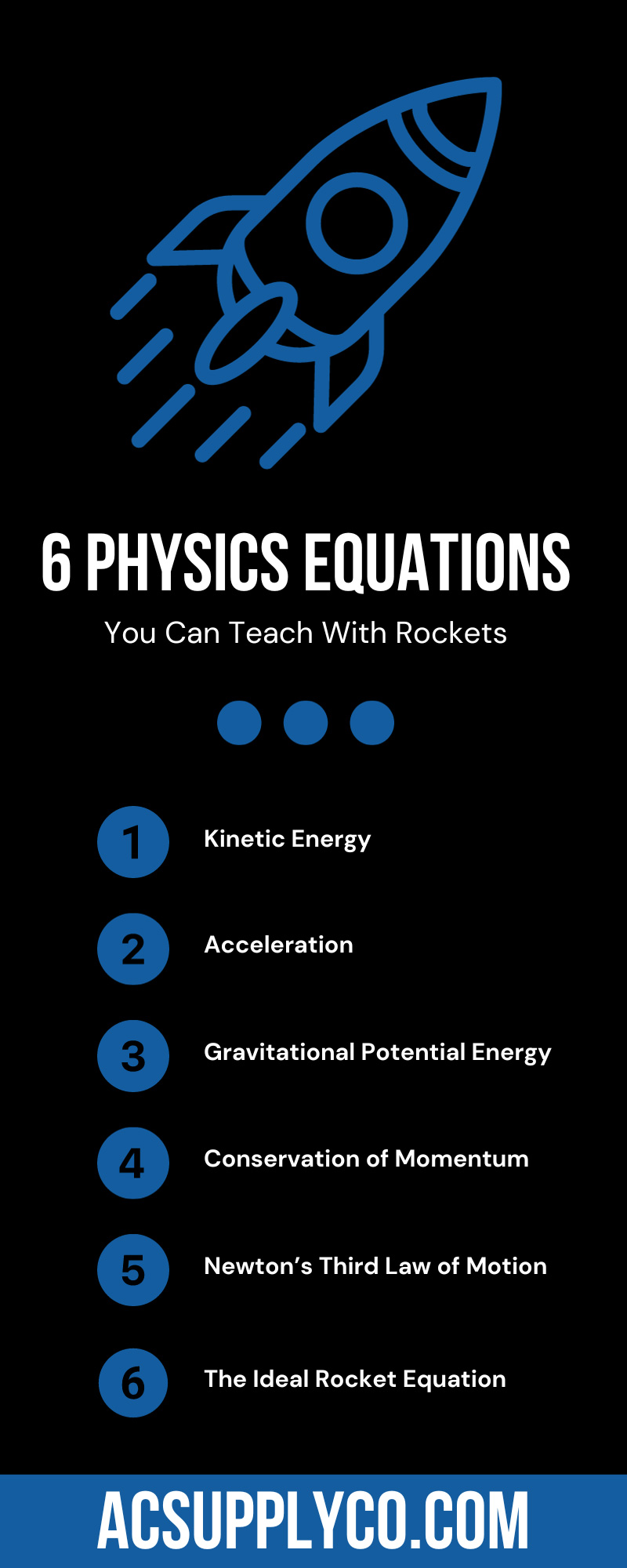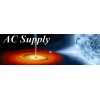The study of physics has the potential to open worlds of understanding for students. They can learn about the principles that govern motion, energy, and the fundamental behavior of matter. Nothing is more exciting for a teacher than explaining these concepts in a cool and interesting way. Here are six physics equations you can teach with rockets, offering an avenue for students to engage with physics in a practical, hands-on way.
Kinetic Energy
Kinetic Energy is the energy of motion. A rocket embodies kinetic energy in action when it shoots up into the sky. The equation for kinetic energy is KE = ½ mv^2, where “m” represents mass and “v” represents velocity.
By analyzing a rocket’s mass and the velocity at which it soars, students can calculate the amount of kinetic energy the rocket possesses. They can further experiment by altering the rocket’s mass or launching speed and observing how these changes affect its kinetic energy.
Acceleration
Acceleration is a fundamental concept in physics, and rockets can experience extreme acceleration during a launch. The equation for acceleration is a = Δv/Δt, where “a” represents acceleration, Δv represents the change in velocity, and Δt represents the change in time.
As rockets blast off and pick up speed over time, students can measure and calculate the rate of acceleration, grounding their understanding of this concept in tangible experience. Students can also compare the acceleration of their model rockets to the acceleration of actual rocket launches.
Gravitational Potential Energy
As a rocket ascends, it works against the Earth’s gravitational pull, creating an excellent example of gravitational potential energy (GPE). The equation for gravitational potential energy is GPE = mgh, where “m” equals mass, “g” equals the acceleration due to gravity, and “h” equals the rocket’s height.
Students can compute the gravitational potential energy by measuring the height a rocket reaches and knowing the mass of the rocket and the constant for gravitational acceleration. Exploring gravitational potential energy using rockets is a practical way to introduce students to this foundational physics concept.
Conservation of Momentum
The principle of Conservation of Momentum is crucial in understanding rocket propulsion. The equation p = mv, where “p” represents momentum, “m” represents mass, and “v” represents velocity, explains how a rocket conserves momentum when propelling fuel downwards to soar upwards. Students can observe and measure the mass and velocity of expelled fuel and the rocket to see how momentum conservation plays a crucial role in rocketry.
Newton’s Third Law of Motion
One of the core tenets of physics, Newton’s Third Law of Motion, states that for every action, there is an equal and opposite reaction. You can see this principle demonstrated clearly in rocket propulsion. As rockets expel fuel downwards at a high speed, an equal and opposite force propels the rocket upwards. Students can observe Newton’s Third Law through rocket launches, providing a visceral understanding of this fundamental law of motion.
The Ideal Rocket Equation
The Ideal Rocket Equation, derived from Newton’s laws, provides a theoretical framework for understanding rocket propulsion. The equation is Δv = Isp * g0 * ln(M0/Mf), where “Δv” is the change in velocity, “Isp” is the specific impulse, “g0” is the acceleration due to gravity at sea level, “M0” is the initial mass, and “Mf” is the final mass of the rocket.
Utilizing this equation, students can delve deeper into the physics of rocketry, exploring the relationship between the rocket’s mass, the efficiency of its propulsion system, and the attainable change in velocity. Out of the six physics equations you can teach with rockets, the ideal rocket equation may seem the most complex. However, with time, your students will begin to see how these concepts intersect, making them easier to understand.
Top Reasons Why Every Student Should Study Physics
Physics, one of the world’s oldest academic disciplines, explains how things work. Studying physics will help your students understand it all if they are curious about the world. Here are some of the top reasons why every student should study physics:
Critical Thinking and Problem Solving
Physics problems often require abstract thinking, logical reasoning, and the application of multiple concepts to find a solution. These skills are valuable in any career and daily decision-making.
Practical Applications
Physics is present everywhere in our daily lives. A grounding in physics helps demystify the world around us, whether we want to understand how a microwave heats our food, why the sky is blue, or how our electronic devices work. It also gives us a knowledgebase to use when solving real-world problems.
Foundation for Other Sciences
Many chemistry, biology, and Earth science concepts have direct connections to physics principles. For instance, understanding the physics of light and optics is essential in biology when using microscopes. By having a firm understanding of basic physics, students may have an easier time taking other science classes.
Career Opportunities
A background in physics is a gateway to many careers, not just in physics research but also in engineering, computer science, medicine, finance, and more. With the ever-changing tech landscape, commercial businesses and government organizations always need employees with practical knowledge of physics concepts.Developing Mathematical Skills
Physics often involves the application of mathematical concepts to solve problems. A basic understanding of physics can reinforce mathematical knowledge and build a strong foundation for students in algebra, calculus, and statistics.
Fostering Curiosity
Physics poses fundamental questions about the nature of reality, the origins of the universe, and the behavior of matter and energy. Exploring these questions can spark a student’s curiosity and lead to a lifelong pursuit and love of learning.
Capture your students’ interest by introducing model rocket kits for schools into your lesson plans. Model rocket building is a great way to teach basic physics concepts and help students with long-term retention of the material.
Ignite the Flame of Curiosity Within Your Students
Learning about rockets is a captivating and effective way to instill a deeper understanding of physics principles in students. Using model rockets in schools allows students to engage with complex physics equations in a hands-on, experiential manner.
Ignite the flame of curiosity within your students by purchasing educational model kits for the classroom. At AC Supply, our range of wholesale model kits will help your students develop a lifelong interest in STEM learning. They will ensure your students remain interested in your class and invested in learning new concepts.
Check out our website or give us a call for more information about our model rocket starter sets. Our knowledgeable staff will help you with your project needs and provide quick, efficient service. We look forward to helping you provide your students with a fun and exciting way to learn about physics!



